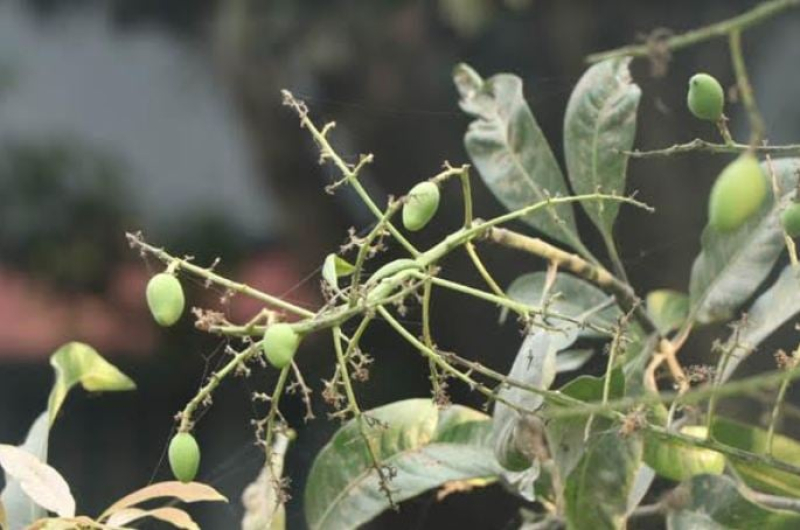- DMP issues 7 traffic directives for Osman Hadi’s Janaza |
- Vested quarter fuelling chaos to impose new fascism: Fakhrul |
- Hadi’s namaz-e-janaza at 2:30pm Saturday |
- Jashore’s Gadkhali blooms with hope; flowers may fetch Tk4 bn |
- Dhaka’s air quality 6th worst in the world this morning |
Prolonged heat wave: Mango farmers in Rajshahi region alarmed

Mango growers fear crop loss due to prolonged heat wave.
Rajshahi, April 24 - Prolonged heat wave has frustrated the mango farmers, traders and others concerned as around 60 percent of immature mangoes have reportedly fallen due to the natural calamity in the region.
There are mango orchards on 93,266 hectares of land in Rajshahi, Chapainawabganj, Naogaon and Natore districts. Target has been set to produce around 12.5 lakh tonnes from the orchards during the upcoming season.
With the mercury rising to unbearable levels, farmers of seasonal fruit are worried that the heat may affect the harvest. This may mean fewer mangoes this summer which, no doubt, is also bad news for lovers of the delectable seasonal fruit.
It's painful for Tajul Islam to see what has happened to his beloved mango orchard in Rajshahi city's Borobongram Namopara.Amid the ongoing heatwave and absence of rain, almost half of his 25 mango trees have shed their flower buds before they could become mature fruits.
The situation is particularly worrying in Bagha upazila, the region known for its famous Khirsapat, Langra, and Gopalbhog mango varieties.
Shafiqul Islam Sana, a mango grower from Bagha, who sold mangoes worth about Tk1 crore last year, is cultivating mangoes on 300 bighas of land this year as well. However, he is disappointed as fewer mangoes have appeared on the trees.
Dr Shafiqul Islam, principal scientific officer of the Fruit Research Station, attributed that last year's bumper crop resulted in less food storage in the trees, leading to a lower bud count this year. But reduced production this year is anticipated to yield larger mangoes of higher quality.
He said the buds have come late on the trees due to the prolonged winter. Usually, buds appear on most trees in early February, but this time buds started appearing on trees in late February.
Another unusual observation is the uneven distribution of buds. Some orchards have trees with full bud coverage while neighbouring trees have none, with only new leaves emerging.
This pattern is also seen on individual trees, where one branch may be covered in buds while the other remains bare.
Similar conditions are observed in Charghat upazila, where farmers report only seeing leaves on their trees rather than mango pods.
Saiful Islam, a farmer of Laodara village in Charghat Upazila said, "Only leaves are coming on the trees this time. There are no mangoes."
Motaleb Hossain, another farmer, commented sarcastically that mango farmers might have to "feast on leaves" this year.
Biplob, a mango grower of Chara Bottola village under the same upazila, said that he sold Tk22 lakh worth of mangoes last year. This year he will not even get Tk 2 lakh worth of mangoes.
There was a bumper production of mangoes last year. However, it was not possible to make a profit due to not getting the expected price of mangoes.
Yadul Islam, who has rented 376 mango trees inside the field of Bangladesh Council of Scientific and Industrial Research for three years, said that although the buds are less in other places, the buds in his orchard were good this year, with about 75 percent of the trees having mango buds.
Al Mamun Hasan, Upazila Agriculture Officer in Charghat, said that 50 percent of the buds have turned into pods in the upazila.
The DAE also confirmed that 65 percent of the mango buds in the district are currently pea-sized and 35 percent are marble-sized. Pods have appeared on 500 out of 900 trees in his orchard. Farmers are busy taking care of them and have done the second round of pesticide spraying on the trees.
Mahmudul Faruque, additional director of the DAE, said that mangoes survive by facing natural calamities. If the existing immature mangoes on the trees survive and the farmers take proper care, the target set for mango production will be met.
According to the sources of the Department of Agriculture Extension (DAE), 12,07,263 tonnes of mangoes were harvested last season But there is an apprehension of declining mango yield this year.
In Chapainawabganj, there are orchards on 37,604 hectares of land with the prediction of yielding 4.5 lakh tonnes of mangoes. In Naogaon, another mango producing district, around 4.32 lakh tonnes of mangoes are expected from 30,300 hectares of land.
Rajshahi district is expected to yield around 2.60 lakh tonnes of mangoes from 19,602 hectares of land this year. Source: BSS

